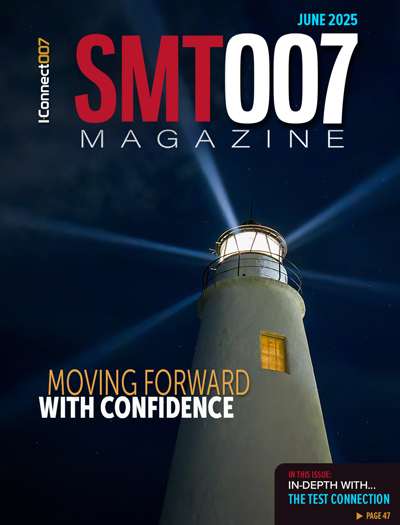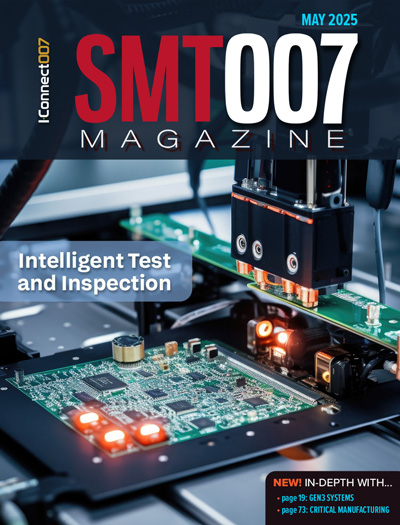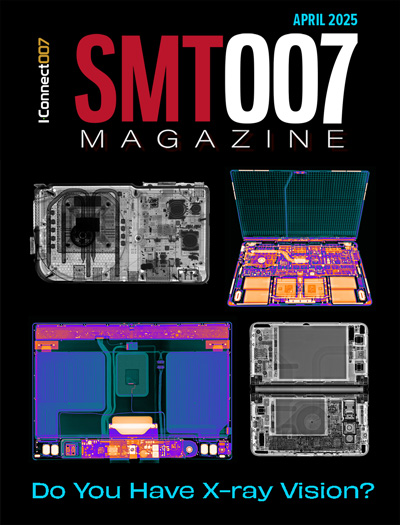-

- News
- Books
Featured Books
- smt007 Magazine
Latest Issues
Current Issue
Moving Forward With Confidence
In this issue, we focus on sales and quoting, workforce training, new IPC leadership in the U.S. and Canada, the effects of tariffs, CFX standards, and much more—all designed to provide perspective as you move through the cloud bank of today's shifting economic market.

Intelligent Test and Inspection
Are you ready to explore the cutting-edge advancements shaping the electronics manufacturing industry? The May 2025 issue of SMT007 Magazine is packed with insights, innovations, and expert perspectives that you won’t want to miss.

Do You Have X-ray Vision?
Has X-ray’s time finally come in electronics manufacturing? Join us in this issue of SMT007 Magazine, where we answer this question and others to bring more efficiency to your bottom line.
- Articles
- Columns
Search Console
- Links
- Media kit
||| MENU - smt007 Magazine
VJ Electronix: Automating the X-ray Inspection Process
May 4, 2022 | Nolan Johnson, I-Connect007Estimated reading time: 2 minutes
Brennan Caissie shares the benefits of a new inspection tool that can be used on a variety of boards, with an automated system that takes the pressure off the manufacturing floor operators and can provide feedback all the way to the design process.
Nolan Johnson: Brennan, can you explain what you do as an applications engineer?
Brennan Caissie: Yes. I interact with customers, working with them to find their needs, translate that back to our engineering group and come up with solutions for customer applications. VJ Electronix specializes in X-ray inspection, X-ray counting for components, and rework machines.
Johnson: You have some news coming out of VJE about some new products. Could you fill us in?
Caissie: Sure. We have a new product coming out called the Apogee 90, which is a 90-kiloVolt PCB inspection machine. The Apogee 90 is primarily aimed at customers generating consumer electronics, medical components, products with smaller and lighter boards. This machine is going to have some software capabilities that are new for us. There’s BGA analysis, for example. We also have some automated filters and automated inspection routines. We can tilt the detector in the machine to get angled images. There are quite a few new features we are bringing to this machine.
Johnson: Angled images? In that regard, are you starting to rely on more than just 2D contrast for identification? Are you starting to use a little bit of a 3D angle at this?
Caissie: That’s right. It’s not quite 3D, but more than a top-down 2D image. We can tilt the detector in the machine up to 45 degrees so we can get an angled image so you can see the top and bottom of structures like vias, to see exactly where the solder is placed in three dimensions.
Johnson: What’s the advantage to these angled images?
Caissie: In boards where you have multiple layers, it is sometimes helpful to look inside through-holes and vias just to see if the solder is completely filling those areas with no voids in the solder.
Johnson: The additional angles certainly help you get a more complete picture of what’s going on there.
Caissie: That’s right. You can also use that feature to look around some tall components that might be blocking your view. You can angle the detector to see around those types of components as well.
Johnson: You have some capabilities within the Apogee to handle some different types of boards. What makes that challenging? Why does that require you to do something different?
Caissie: We have a 90-kiloVolt system, which is good for smaller, thinner boards. When you get into the larger boards with multiple layers, it does get a little more difficult for that X-ray to penetrate all the way through. We have a 130-kiloVolt version coming that will be more appropriate for those types of applications.
Johnson: Because of the board type, you need to optimize. One system is not going to work for every board thickness.
Caissie: That’s right. We typically use the higher power system for applications like server boards and automotive components. Those thicker boards are going to require more power to penetrate through those boards to see all the different layers.
This interview originally appeared in the May issue of SMT007 Magazine. Click here to continue reading.
Suggested Items
BEST Inc. Introduces StikNPeel Rework Stencil for Fast, Simple and Reliable Solder Paste Printing
06/02/2025 | BEST Inc.BEST Inc., a leader in electronic component rework services, training, and products is pleased to introduce StikNPeel™ rework stencils. This innovative product is designed for printing solder paste for placement of gull wing devices such as quad flat packs (QFPs) or bottom terminated components.
See TopLine’s Next Gen Braided Solder Column Technology at SPACE TECH EXPO 2025
05/28/2025 | TopLineAerospace and Defense applications in demanding environments have a solution now in TopLine’s Braided Solder Columns, which can withstand the rigors of deep space cold and cryogenic environments.
INEMI Interim Report: Interconnection Modeling and Simulation Results for Low-Temp Materials in First-Level Interconnect
05/30/2025 | iNEMIOne of the greatest challenges of integrating different types of silicon, memory, and other extended processing units (XPUs) in a single package is in attaching these various types of chips in a reliable way.
E-tronix Announces Upcoming Webinar with ELMOTEC: Optimizing Soldering Quality and Efficiency with Robotic Automation
05/30/2025 | E-tronixE-tronix, a Stromberg Company, is excited to host an informative webinar presented by Raphael Luchs, CEO of ELMOTEC, titled "Optimize Soldering Quality and Efficiency with Robotic Automation," taking place on Wednesday, June 4, 2025 at 12:00 PM CDT.
CE3S Launches EcoClaim Solutions to Simplify Recycling and Promote Sustainable Manufacturing
05/29/2025 | CE3SCumberland Electronics Strategic Supply Solutions (CE3S), your strategic sourcing, professional solutions and distribution partner, is proud to announce the official launch of EcoClaim™ Solutions, a comprehensive recycling program designed to make responsible disposal of materials easier, more efficient, and more accessible for manufacturers.


